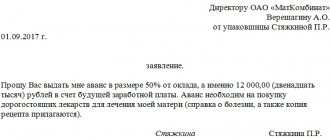Advances received – postings
Accounting for advances received from buyers as payment for goods before their shipment is kept on the account. 62.2 “Advances received.” Prepayments for products are also reflected here if the seller, for various reasons, violates the sales deadlines. Regular settlements are carried out in subaccount 62.1.
Example
Let’s assume that the supplier company “Spectrum” and the buyer “Titul” entered into an agreement for the shipment of electrical equipment for a total amount of 708,000 rubles, including VAT 18% - 108,000 rubles. According to the terms of the transaction, payment is made with 100% prepayment, which was received into the Spectrum account on December 5, and the shipment was completed on December 8. The Spectra accountant will reflect the transactions as follows:
- 5.12 – advance payment received from the buyer, posting D 51 K 62.2 for 708,000.
- 5.12 – VAT charged D 76.AV K 68.2 on 108,000.
- 8.12 – equipment D 62.1 K 90.1 was delivered for 708,000.
- 8.12 – VAT allocated D 90.3 K 68.2 for 108,000.
- 8.12 - advance payment credited, posting D 62.2 K 62.1 for 708,000.
- 8.12 – VAT restored D 68.2 K 76.AB for 108,000.
Conclusion - when receiving advances, transactions regarding the calculation of VAT for payment are carried out 2 times: at the time the money is received in the current account and directly upon sale. Then, after shipment, the advance payment is counted and the amount of VAT from it is restored through reverse posting.
https://youtu.be/YYW8_wGPqpU
Postings for accounting for VAT on advances received
The accountant's algorithm for calculating VAT on advance payments is as follows:
- Upon receipt of an advance from the buyer, posting D51 K62.2
. - According to the Tax Code of the Russian Federation, from this advance we must... To do this, we will attract an additional account 76 “Settlements with various debtors and creditors”, we will open an additional sub-account “Advance” on it, in which we will reflect VAT on advances received from customers. Posting for calculating value added tax on advance D76.Advance K68.VAT.
This posting is carried out on the day the advance payment is received. - After some time, we ship the goods against the funds received, posting D62.1 K90.1.
- From the sale we must also charge tax for payment to the budget, entry D90.3 K68.VAT.
Posting is carried out on the day of sale. - After shipment, it is necessary to offset the advance payment against the buyer's debt using posting D62.2 K62.1
. - As a result of these actions, we see that the tax was assessed twice: on the advance and on the sale. In order not to pay double VAT to the budget, our last action will be posting D68.VAT K76.Advance
- value added tax is accepted for deduction in connection with the sale of goods paid in advance, thereby account 76.Advance will be closed, and the budget will be the correct amount has been paid.
Advances issued – postings
Advances transferred to the company's supplier counterparties are taken into account in the account. 60.2 “advances issued”, normal operations are carried out on subaccount 60.1. In situations where the amounts of prepayments turn out to be greater than the sales amounts, the difference remains with the supplier as payment for planned deliveries or is returned at the request of the buyer to the specified details.
Let’s assume that Dorstroy LLC purchases materials for production from RPK LLC. On November 25, Dorstroy transferred an advance payment in the amount of 354,000 rubles, and the goods and materials were received at the warehouse in full on December 2. The Dorstroy accountant should reflect these transactions in the following order:
- 25.11. – advance payment is transferred to the supplier – posting D 60.2 K 51 for 354,000.
- 25.11 – VAT is accepted for reimbursement in the presence of an advance invoice from “RPK” D 68.2 K 76.AB for 54,000.
- 2.12 – materials received D 10.1 K 60.1 for 300,000.
- 2.12 – VAT allocated D 19.3 K 60.1 for 54,000.
- 2.12 – the advance was offset, posting D 60.1 K 60.2 for 354,000.
- 2.12 – previously refunded VAT D 76.AV K 68.2 was accrued for 54,000.
- 2.12 – VAT offset was completed upon completion of the transaction D 68.2 K 19.3 for 54,000.
When accounting for VAT on prepayments issued, you should keep in mind that the tax can be reimbursed without waiting for the goods to be shipped. The justificatory grounds are listed in Art. 172 clause 9. These are the following documents:
- Advance invoice submitted by the supplier.
- A document confirming payment of the advance payment.
- An agreement specifying the terms of the advance payment.
Attention! When an advance is issued to the supplier (the posting is given above), the invoice is issued for the amount of the advance payment, and upon shipment - for the sales amount. At the same time, it is legally possible to restore VAT even in the event of complete termination of a transaction for which an advance payment with VAT was previously transferred.
Accounting for repayment and write-off of debt to suppliers
In its structure, account No. 60 is active-passive : its debit records the amounts of obligations fulfilled to suppliers (taking into account advances and prepayments), its credit records the cost of completed work (services rendered) accepted for accounting in correspondence with the corresponding accounts for their accounting.
The basis for the entry is such primary documents from the supplier as a delivery note, a certificate of completion of work, an invoice, etc. In practice, management accounting is more often maintained by enterprises in the context of specific invoices presented for payment. A well-structured individual chart of accounts for a specific organization can allow for separate accounting, for example, by the maturity of debts, uninvoiced supplies, etc.
Important! All transactions taking place on account 60 must be reflected on it in a timely manner and regardless of the fact of payment. All received inventory items are reflected strictly in the same amount as they were determined in the provided settlement documents.
For uninvoiced deliveries, the invoice will be credited for the value stated in the valid contract between the buyer and supplier.
Repayment of debt to the supplier (contractor) is reflected in the debit of account 60
Any resulting accounts payable to any suppliers of goods and materials and services can arise exclusively in two cases:
- when the organization has not paid its counterparties for the goods (services) supplied;
- when any advance payment has been received, but the organization has not yet fulfilled its obligations.
Let us remind you that any outstanding accounts payable must be written off within the time limits established by PBU No. 34 . Business rules usually operate for a period of three years (the statute of limitations).
Accounting for all financial transactions with counterparties can also be kept in journal order No. 6 , which combines both analytical and synthetic accounting.
Any resulting debt is written off as a debit to the account we are considering.
Below are examples of such operations:
| D | TO | Description |
| 60 | 50 | The accumulated debt to suppliers was transferred from the company’s cash |
| 60 | 51 | A similar debt of the enterprise to suppliers was repaid/paid from the current account |
| 60 | 52 | Repayment of a similar debt in foreign currency |
| 60 | 62 | Settlement of counterclaims |
| 60 | 76 | Withholding the amount of the claim from accounts payable to the counterparty |
| 60 | 91 | Outstanding accounts payable are included in the company's expenses |
If three years have passed since the indebtedness to the supplier (contractor) arose (that is, the statute of limitations has expired), then you must write it off
Transfer of advance payment to the supplier
If an advance is transferred to the supplier in advance, then a sub-account with the same name “Advance issued” should be opened on account 60. After receiving the delivery for which the advance was issued, it is offset by the following entry: D60 K60 (subaccount “Advance issued”).
Let's give an example: organization “One” transferred an advance payment to its supplier organization “Two” in the amount of 100,000 rubles. A week later, goods from organization “Two” arrived at organization “One” for the full cost of the advance payment.
At the time of transfer of the advance, “Odin” makes the following entry:
D 60/2 K 50 (51.52) 100,000 rubles (based on a payment order or bank statement).
In a week we will receive the goods received:
D 10 (41) K 60/1 84,446 rubles (based on the delivery note, invoice).
We immediately note VAT:
D 19 K 60/1 15,254 rubles (100,000 * 18: 118) (based on invoice).
And we offset the advance:
D 60/1 K 60/2 100,000 (based on a certificate).
If you do not want to exercise the right to deduct VAT on advances paid to the supplier, do not use it. Applying such a deduction is your right, not your obligation.
Paying off debt in cash
Repayment of debt to the supplier for goods in cash from the company's cash desk is reflected in the following entry: D 60 K 50 .
In this case, various subaccounts to account No. 50 can be used:
- 1if the money was issued from the main cash register of the enterprise;
- 2, if the money was issued from various commodity cash desks: post offices, commodity offices, etc.;
- 3, if bills of exchange and similar monetary documents were used.
Advance reports - accounting entries
In addition to settlements with counterparties - buyers and suppliers, the company regularly issues funds to its employees. How to correctly make accounting entries for expense reports? And is it true that the amount from the advance report is deducted from profit? Let's look at a specific example.
Example of settlements with accountable persons regarding advances issued:
The Pit Stop enterprise reported to employee E.I. Kovalev. for a business trip 8,000 rubles. Kovalev spent 5,400 rubles, and unused funds amounted to 2,600 rubles. returned to the cashier. The accountant will need to do the following:
- An advance was issued for travel expenses - posting D 71 K 50 for 8000.
- The balance of unspent money was returned - posting D 50 K 71 for 2600.
The accountable person is obliged to report on the expenditure of funds within 3 days after the end of the issuance period, and in the case of being on a business trip - after the employee returns. Specific deadlines are set by the head of the organization. If an employee, without good reason, has spent more than the allocated funds and is unable to account for them, the excess is withheld from his income. Buh. The entries for expense reports in this situation look like this:
- The amount not returned on time is reflected - D 94 K 71.
- The shortfall from the employee’s earnings is withheld - D 70 K 94, but not more than 20% monthly.
Debts of buyers and suppliers in accounting
Damn, well, basic postings!!! D26 K70 - wages accrued At the end of the month (we do it at the end of the quarter - a small enterprise), account 26 is closed: D90/8 Management.
You have the right to sue for the employer’s delay of your work record and demand compensation for forced absence.
Write-off of overdue accounts payable from previous years is carried out only after an inventory has been carried out. Its size is also determined based on the results of the inventory and can be included in the revenue part on the basis of an order from the head of the organization.
You have the right to sue for the employer’s delay of your work record and demand compensation for forced absence.
The limitation period begins from the moment the organization discovers a violation of its rights. The organization has the right to write off accounts payable on the day following the day the three-year period begins.
Received a short-term loan on the current account 3. Received a patent from the founders 51 to 50 14 Repaid debts to suppliers, see opera.
Advance paid to supplier: posting
When a prepayment (advance payment) is transferred to the supplier, the entry in the buyer’s accounting is formed, at first glance, the same as when repaying the debt for goods, work, or services supplied:
Debit of account 60 “Settlements with suppliers and contractors” - Credit of accounts 50 “Cash”, 51 “Settlement accounts”, 52 “Currency accounts”, etc.
However, in accordance with the Chart of Accounts and the Instructions for its application (Order of the Ministry of Finance dated October 31, 2000 No. 94n), analytical accounting on account 60 should provide separate presentation of information, including on advances issued.
In addition, as a general rule, offsets between items of assets and liabilities in the balance sheet are not allowed (clause 34 of PBU 4/99). This means that accounts receivable for advances issued and accounts payable for settlements with suppliers should be shown separately in the balance sheet: in assets and liabilities, respectively.
To achieve these goals, a subaccount “Advances issued” is usually opened to account 60.
Therefore, for advances issued, the posting will look like this:
Debit account 60, subaccount “Advances issued” - Credit accounts 50, 51, 52, etc.
And if an advance was received from the buyer, the entry will be similar to the entry for the buyer’s repayment of his debt. However, similar to account 60, to differentiate between the debit and credit balances of account 62, subaccounts are added to it.
So, for advances received the posting will be as follows:
Debit of accounts 50, 51, 52, etc. – Credit of account 62, subaccount “Advances received”
It is clear that the accounting entry “Debit 51 - Credit 62” means that the seller received funds from the buyer to the current account.
Note that if an advance is issued to a supplier, the posting is made to a separate subaccount to account 60. But if an advance is issued for travel expenses, posting to a separate subaccount to account 71 “Settlements with accountable persons” is not made. This is due to the fact that the same accountable person cannot have both receivables and payables at the same time.
Postings for advance received from buyer
If an enterprise receives an advance payment for services or work that have not yet been completed under the contract, then such an advance is accounted for in account 62. This account is also used when funds are received for any products that were not delivered to the customer at the time the money was received.
An example of a reflection of an advance received for goods (services, work)
Let’s say that “Factor” has entered into an agreement for the supply of printed products, where “Omega” is the supplier and “Factor” is the buyer. The contract amount is 321,000 rubles. On 10/01/2015 the customer makes full prepayment under the contract. On November 1, 2015, the supplier transfers part of the goods in the amount of 120,000 rubles.
This operation will look like this:
| Dt | CT | Description | Sum | Base |
| 51 | 62.02 | Receipt of advance payment from the buyer to the account | RUB 321,000 | invoice, bank statement |
| 62.02 | 68 | VAT accrual (18% of the advance amount) | RUB 48,966 | invoice, bank statement |
| 62.01 | 90/1 | Supply of printed products | 120,000 rub. | waybill |
| 90/3 | 68 | VAT accrual (18% of the delivery cost) | RUB 18,305 | waybill |
| 68 | 62.02 | VAT recovery | RUB 18,305 | waybill |
| 62.02 | 62.01 | Closing the received advance for the amount of goods delivered | 120,000 rub. | waybill |
Postings for advances issued in favor of the supplier
To account for advances transferred by the enterprise to pay for services, work and finished products, account 60 is used. The organization carries out settlements with accountable persons using account 71.
Reflection of the prepayment transferred to the seller for raw materials and materials
Let's consider an example: I ordered raw materials for the production of products from the Atlet enterprise and paid 48,000 rubles in advance on 04/05/2015. 06/01/2015 Atlet supplied raw materials to the Sigma warehouse.
The customer’s accounting must reflect the following accounting entries for the advance:
| Dt | CT | Description | Sum | Base |
| 60.02 | 51 | The advance payment issued to the Atlet enterprise was transferred | 48,000 rub. | invoice |
| 10/1 | 60.01 | Atlet supplied raw materials and materials in full | RUB 39,360 | waybill |
| 19/3 | 60.01 | VAT (18% of the cost of the goods received) | RUB 8,640 | waybill |
| 60.01 | 60.02 | Crediting the supplier's advance upon delivery of goods | 48,000 rub. | waybill |
| 68.02 | 19.03 | VAT credit upon delivery of goods | RUB 8,640 | waybill |
How to reflect an advance to an employee for business needs
Inter LLC issued to its employee Sviridov V.P. advance payment in the amount of 5,200 rubles for the purchase of stationery. Sviridov purchased office supplies in the amount of 4,850 rubles, and returned the remaining unused funds of 350 rubles to the cash desk of Inter LLC.
| Dt | CT | Description | Sum | Base |
| 71 | 51 | Sviridov received an advance on his card account | 5,200 rub. | application for funds |
| 10 | 71 | Reflection of purchased goods | 4,850 rub. | expense report |
| 50 | 71 | Sviridov returned unspent funds to the cash register | 350 rub. | expense report |
Paperwork
Often, legally competent drafting of documents upon acceptance of goods and materials helps resolve disputes between the supplier and the buyer if such arise, for example, due to inadequate quality of received materials.
Let's consider the case when a supply agreement is concluded between the supplier and the buyer. If in this case inventories are transported, then the supplier must bring an invoice or bill of lading along with them.
He must also provide an invoice (remember that the invoice is the basis for payment for materials)
Next, an employee of the purchasing company (the financially responsible person) checks the composition of the delivered material with the delivery note and invoice and, if everything is in order, signs the documents (each in 2 copies) and keeps one of the copies for himself. Further, both in the purchasing company and in the supplying company, copies of these documents must be signed by an authorized person, and they must be stamped.
If the received supplies do not correspond to the description in the accompanying document or the packaging is severely damaged, it is necessary to draw up a materials acceptance report.
If everything is in order, the buying company can create a receipt note with a list of received materials.
If a materially responsible person accepts goods outside the warehouse of the purchasing company, then a power of attorney to receive materials must be issued to this person.
The delivery note is the basis document for transactions 1, 2 and 3 in the list of transactions for delivery under a post-payment agreement, a receipt order is for 1, an invoice is for 2. A bank statement is for 4.
What if the oil and gas plant was acquired by an accountable person? Then an advance report, which has already been discussed (in one copy), is required, as well as cash receipts and other documents confirming the fact of payment. In the process of transferring materials to the warehouse by the accountable person, a receipt order is issued.
This receipt order is the basis for posting 2 in the list of postings when materials are received through an accountable person according to the standard scheme, and a delivery note is also required for its posting. For 1 transaction - an expense order. For 3 – invoice and delivery note. For 4 - the same as for 3, and also requires a purchase book.
If the accountant uses a scheme that includes payments to suppliers, then entry 5 from this list will require an accounting statement.
If the goods were received under an exchange agreement, then invoices are required for 1, 2, 3, 4 and 5 transactions; receipt order – for 1; invoices – for 2, 3, 4, 5 and 6; accounting certificate-calculation – for 7.
Settlements with suppliers and contractors: accounting accounts
Typically, all settlements with suppliers are carried out on active-passive account 60 “Settlements with suppliers and contractors” in accordance with the Chart of Accounts, approved by Order of the Ministry of Finance of the Russian Federation dated October 31, 2000 No. 94n (as amended on November 8, 2010). It is advisable to provide sub-accounts for the invoice, the use of which will depend on how payment is made: for goods already shipped (60.1) or in advance (60.2). The working chart of accounts of the subject can also introduce additional sub-accounts to this account, if this is necessary to build correct analytical accounting.
NOTE! For settlements with other suppliers and contractors, some business entities open a corresponding sub-account to account 76 “Settlements with various debtors and creditors”. Within the framework of this article, we analyze transactions involving account 60 - as the most typical for this section of accounting.
Transactions related to payment to the supplier are carried out in the debit of the specified account. How accounting entries appear in accounting and what they represent, we will describe below.
Reflection of advance transactions in the declaration: postings, restoration
In accounting, VAT is charged on the advance received from the buyer using the following entries:
To reflect the accrual of VAT on advance payments, the chart of accounts provides a subaccount “VAT on advances received (prepayments)” to account 62 “Settlements with buyers and customers” and account 76 “Settlements with various debtors and creditors”. This allows:
- keep in accounting data on advances received and VAT on them (according to Kt 62, 76);
- in the balance sheet, reflect the amounts of advances received (excluding VAT, accounted for on the Dt of the relevant accounts) as accounts payable.
Please note that the previously received advance payment at the time of sale of goods (services or work) is counted towards the prepayment amount. An invoice is issued for the shipped product (service or work). On the date of offset of advances, the company accepts for deduction VAT on advances received. Please note that the deduction is made in the amount of tax calculated on goods (services or work) shipped for which advances were received. It is understood here that if VAT on advances is charged at a rate of 20/120%, and the product (service or work) is shipped at a rate of 10%, then VAT on advances received is credited at a rate of 10/110%.
In the VAT return, the advance received is reflected in section 3 on line 070 in column 3, and the amount of tax on the advance is reflected in column 5.
The deduction of VAT on advances received is reflected in section 3 of the declaration on line 170 in column 3 for the tax period in which the goods were shipped.
Reflection in accounting of VAT on the advance paid to the supplier is reflected by postings.
Account 19 is used for the purpose of separating VAT from an advance, when the issuance of an advance and the deduction of VAT are separated in time. If advance VAT on the reporting date is not accepted for deduction, then the tax reflected in account 19 is recorded in the balance sheet as a current asset separately from the “receivables” for the transferred advance payment.
To separate VAT from advances issued, you can use separate subaccounts “VAT on advances issued (prepayments)” to account 60 “Settlements with suppliers and contractors” or to account 76 “Settlements with various debtors and creditors”. Thereby:
- the accounting stores data on advances paid, including VAT (according to Dt 60, 76);
- the balance sheet shows “receivables” (minus VAT accounted for in the KT of the relevant accounts) in the form of advances issued.
VAT on advances received, accounted for under Dt 62-VAT (76-VAT), is not indicated in the balance sheet, as well as VAT on advances issued, accounted for under Kt 60-VAT (76-VAT). In the balance sheet, tax amounts are reduced by the “debtor” in the form of advances issued and the “creditor” in the form of advances received.
Reflected in account 19 from the advance VAT issued, which was not accepted for deduction by the end of the reporting period, must be included in the balance sheet. This VAT is indicated in line 1220 “VAT on acquired assets.”
Advances issued are not reflected in the VAT return, but the tax on these advances accepted for deduction is indicated in section 3 on line 130.
Please note that for the advances listed by the suppliers, the buyer acts according to the following scheme:
1) receives an invoice for the advance payment, records it in the purchase book, and accepts the advance VAT for deduction;
2) after shipment of goods (services, works), records the shipping invoice in the purchase book;
3) indicates the previously registered advance invoice in the sales book, thus recovering VAT from the advance payment issued.
Kontur.VAT+ allows you to avoid discrepancies in the quotas and reconciles invoices for transactions with advances for all quarters.
Find out more
Regarding the recovery of VAT from an advance received, the situation is as follows. The seller, having received an advance payment, charges VAT on it. Having sold the goods (service, work), he draws up an invoice for the sale and accepts VAT from the previously received advance for deduction. That is, in this case the term “restoration” is incorrect to use. The seller records an advance invoice in the sales book, and later, after shipment of the goods (service, work), an invoice for sales. At the same time, the seller registers an invoice for the advance payment in the purchase book, thereby deducting advance VAT. Oh, that is, the deduction, VAT on the advance received is not limited, the main thing is that the deduction is declared in the quarter in which all the conditions for the deduction are met.
Posting - transferred from the current account to suppliers
Purchasing raw materials, materials, goods, fixed assets, intangible assets, works, services by transferring non-cash funds is a simple process. This usually happens in several stages:
- A supply agreement (performance of work, provision of services) is concluded between economic entities.
- The supplier issues an invoice for payment for materials (work, services).
- The buyer transfers in whole or in part - according to the terms of the contract - the amount indicated in the invoice.
- The shipment is made to the buyer's address.
The stages may vary: someone does without a contract, while all the conditions are written down in the invoice; valuables (work, services) can be paid after their shipment (fulfillment, provision).
The following entries appear in the accounting:
- Dt 60.2 Kt 51 - based on the payment order and bank statement, the transfer of funds to the supplier is reflected on account of the future supply of materials (works, services).
- Dt 08, 10, 20, 25, 41... Kt 60.1 - valuables, works, services are capitalized on the basis of transfer documents (invoices, acts, etc.) Valuables can be delivered directly by the supplier to the buyer, sent through a freight forwarding company, or the buyer picks them up by proxy.
- Dt 19 Kt 60.1 - VAT is reflected if it is highlighted in the supplier’s invoice.
- Dt 60.1 Kt 60.2 - the transferred advance payment is counted against received valuables, works, services.
If payment occurs after shipment, then the last entry in accounting is not made, and account 60.1 will correspond with account 51.
Other transactions - the supplier’s invoice for materials, work, services has been paid
The current account, the transactions with which we examined in the previous section, is most often used in settlements between economic entities. However, payment can be made not only from it; there are other ways to make it. Account correspondence can take the following form:
- Dt 60 Kt 50 - paid to the supplier in cash; the supplier's cash receipt must be attached to the receipt documents if he is required to use a cash register.
- Dt 60 Kt 52, 55 - if payment is made by bank transfer from a foreign currency or specialized account in a banking institution.
The choice of subaccount for account 60 in the proposed entries will also depend on when the payment occurred - before or after the receipt of products, works, services, etc.
If the buyer transfers his own bill of exchange as a guarantee of payment for goods, works, services, then accounts payable from account 60 are not written off, but are reflected in a separate sub-account intended for accounting for bills of exchange. Posting - the supplier's invoice is paid with its own bill of exchange - may look like this:
Dt 60.1 Kt 60 “Settlements on bills issued.”
When repaying his own bill, the buyer will write:
Dt 60 “Settlements on bills issued” Kt 50, 51, 52, 55.
Read about how to create a balance sheet for account 60, taking into account all the entries made in accounting.









